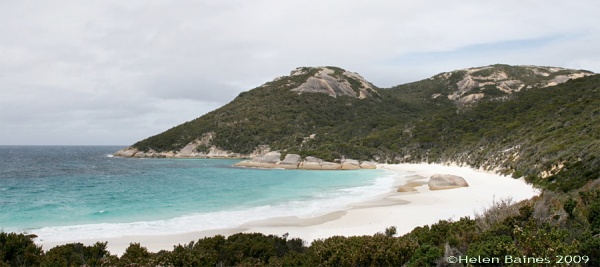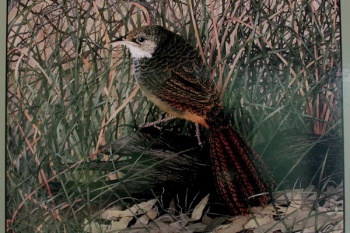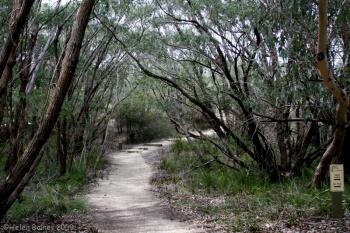
Little Beach, a 2.5 km drive to the east of the Two Peoples Bay Visitor Centre, November 2009
Overview
The Two Peoples Bay Nature Reserve, 4,744 hectares in size, is about 35 kilometres east of Albany, on the south coast of Western Australia. The area consists mainly of heathland and lies between the granite massifs of Mount Gardner and Mount Manypeaks.
The area became famous in 1961, when the Noisy Scrub-bird, thought to be extinct, was rediscovered there. The Nature Reserve was established in 1967 to protect the habitat of this rare bird. About 70 species have been recorded there.
Birds
Notable Species
Noisy Scrub-bird - elusive and rarely seen, though.
Rarities
Endangered species found here: Noisy Scrub-bird, Western Ground Parrot, Western Bristlebird, Western Whipbird (western heath) and the Australasian Bittern.
Check-list
Birds you can see here include:
Australian Shelduck, Stubble Quail, Indian Yellow-nosed Albatross, Flesh-footed Shearwater, Australasian Gannet, Little Black Cormorant, Pied Cormorant, Great Cormorant, Little Pied Cormorant, Australian Pelican, White-faced Heron, Pacific Reef Heron, Australian Kite, Wedge-tailed Eagle, White-bellied Sea Eagle, Spotted Harrier, Square-tailed Kite, Swamp Harrier, Buff-banded Rail, Australasian Swamphen, Pacific Golden-Plover, Pied Oystercatcher, Sooty Oystercatcher, Common Sandpiper, Common Greenshank, Silver Gull, Caspian Tern, Pacific Gull, Great Crested Tern, Brown Skua, Common Bronzewing, Brush Bronzewing, Fan-tailed Cuckoo, Laughing Kookaburra, Nankeen Kestrel, Slender-billed Black-Cockatoo, Galah, Red-capped Parrot, Elegant Parrot, Port Lincoln Ringneck, Rock Parrot, Noisy Scrub-bird, Southern Emuwren, Red-winged Fairywren, Splendid Fairywren, Western Spinebill, Western Wattlebird, New Holland Honeyeater, Red Wattlebird, Tawny-crowned Honeyeater, Western Bristlebird, Spotted Pardalote, White-browed Scrubwren, Inland Thornbill, Western Thornbill, Yellow-rumped Thornbill, Western Whipbird, Gray Butcherbird, Australasian Magpie, Gray Currawong, Black-faced Cuckooshrike, Gray Shrike-Thrush, Golden Whistler, Willie-wagtail, Gray Fantail, Magpie-lark, Australian Raven, Welcome Swallow, Tree Martin, Silver-eye, Australasian Pipit, Red-eared Firetail
Other Wildlife
The Gilbert's Potoroo (Potorous gilbertii), a rat kangaroo, was thought to be extinct, until a population of 40 was discovered at Two Peoples Bay in 1994. Quendas (bandicoots), nocturnal western ringtail possums can also be fond here.
Site Information
History and Use
Two Peoples Bay was named in 1803, when 2 ships arrived at the same time from different countries: a French exploration ship and an American whaler. Prior to this, the bay was a gathering place for the local Indigenous Noongar people, known as the Minang, who hunted and fished along streams that flowed into the bay. The area was made into a nature reserve in 1967, in order to protect the habitat of the Noisy Scrub-bird, which was rediscovered by John Gilbert in 1961, having been thought to be extinct.

Painting of the rare and endangered Noisy Scrub-bird, Two Peoples Bay Visitor Centre, November 2009
Areas of Interest
- Two Peoples Bay Visitor Centre
- Two Peoples Bay Heritage Trail
- Little Beach - a short drive away
- Gull Rock National Park ~ located on the outskirts of Albany
- Mt Martin Botanical Reserve ~ adjacent to Gull Rock NP
- Waychinicup National Park ~ located 65 km east of Albany
- Mt Manypeaks Nature Reserve ~ adjacent to Waychinicup NP
Access and Facilities
- Open daily, but no overnight camping
- Visitor Centre ~ open 10am to 4pm in the summer months, open whenever staff can be present in the rest of the year
- Activities such as bushwalking, beach walking, fishing, boat launching and picnicking are provided within designated areas. Maps are displayed at the Visitor Centre
- 4.6 km return trail from rear of Visitor Centre, loops back along the beach
- 5 km return spur leads to Little Beach
- No camping
- There is no access to certain areas to protect the endangered species in the Reserve
Contact Details
Two Peoples Bay Nature Reserve
Two Peoples Bay Rd
Albany WA 6330, Australia
Tel: +61 (0)8 9842 4500
Content and images originally posted by HelenB
External Links
- Two Peoples Bay on Official Government site for Wildlife Parks
- Rainbow Coast General Information
- Birdwatching in the Albany area







